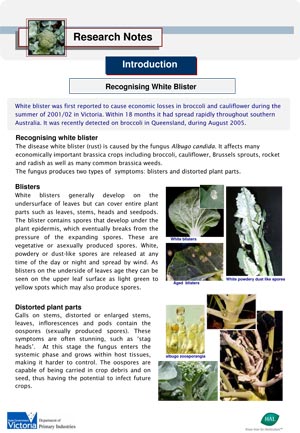|
Recognising White Blister
White blister was first reported to cause economic losses in broccoli and cauliflower during the summer of 2001/02 in Victoria.
Within 18 months it had spread rapidly throughout southern Australia.
It was then detected on broccoli in Queensland, during August 2005.
The disease white blister (rust) is caused by the fungus Albugo candida.
It affects many economically important brassica crops including broccoli, cauliflower, Brussels sprouts, rocket and radish as well as many common brassica weeds.


The fungus produces two types of symptoms:
- White blisters generally develop on the undersurface of leaves but can cover entire plant parts such as leaves, stems, heads and seedpods.
- Galls on stems, distorted or enlarged stems, leaves, flowers and pods
Infection depends on:
- A source of spores
- Temperature range of 13 – 25C
- A minimum of 2-3 hours of leaf wetness
Disease development:
- The disease is more common in autumn and spring
- Symptoms develop 7 to 21 days after infection
White blister produces economic loss by:
- defoliation of seedling leaves, slowing their growth
- premature harvest of broccoli heads to avoid symptom expression
- reduced production period for rocket crops
- damage to radish leaves thus reducing their commercial value
- infections on broccoli heads making them unmarketable
- development of blister on broccoli heads during transit
- increased frequency of fungicide applications.
|

